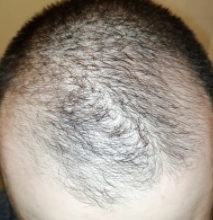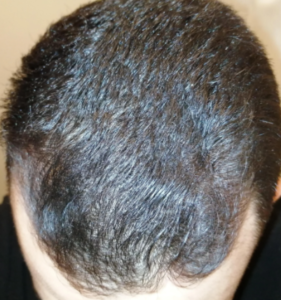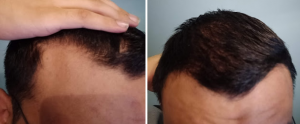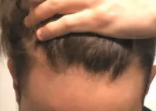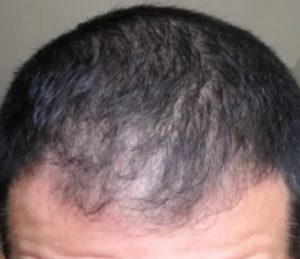Lowering a male hairline is a role for a hair transplant if you are over 25 years of age. I would not seek a hairline advancement surgery (another solution to high hairlines) because male pattern balding (genetic balding) might cause you to lose hair behind the surgery site and expose a scar: https://baldingblog.com/had-a-hair-transplant-at-21-now-at-22-he-has-more-hair-loss/. I would try to reverse the early hair loss with medications such as finasteride and minoxidil and with a little luck, you might get a response like this: https://baldingblog.com/10-months-on-finasteride-fantastic-result-photos/. You need a good doctor who cares about you and will build a Master Plan for you so that you will never look freaky while fixing your forehead or balding problem
I was on Androgel since august 2018 after being diagnosed at 208 nG/dL. The reason I got myself diagnosed in the first place was because of my high pitched voice and lack of (muscle) development. While I was on TRT, I did feel slightly stronger and my biceps did get bulkier and feel significantly firmer to the touch (and I don’t work out). However, around the turn of 2019 I noticed my hair was noticeably thinner. I had always had a dense forest of hair on my head ever since I remember. That changed only after I started TRT. I quit Androgel cold turkey in January, but the damage was done. My hair kept deteriorating so I got a DHT test: 747.67 pg/ml. (Normal range: 250 – 990)
I then got on Dutasteride for a month, but taking it didn’t seem to help so I tested my DHT again while I was on it: 1110.8 pg/ml.
I have since stuck to Finasteride, and my DHT levels dropped to 590 pg/ml then rose to 990 pgml. My ferretin was measured at 48 ng/ml on a range of 30 to 440.
My hair is worse than ever. I have a noticeable bald spot on my crown and my hairline has receded noticeably. My hair now parts naturally in a very noticeable path, looks like severe diffuse thinning. I started fin in march and mine in June, but my hair is worse than ever and sheds more than 100 hairs daily. Hair is frizzy and curly whereas it was straight before trt. Shed hairs are much thinner towards the bulb.
I wish I never took TRT. My hair was fine before TRT and that was not the only thing Androgel affected. I wish I could rewind time back to last year and convince my younger self not to make this irreversible decision.
Unfortunately, many men who go on Testosterone therapy lose their hair if they have the genes for balding. Many older man who had minimal hair loss and then take T therapy, start losing their hair big-time
Is there a way to check whether the hair loss is from chemical burns as opposed to a condition like alopecia?
If there is an event where a chemical burn could have happened, then the burn may limit some or all of the hair growth in the area where the burn happened. I generally say if hair has not grown in 8 months since the incident, then the chemical burn is permanent. Hair Transplants or Scalp Micropigmentation give solutions to this problem along with concealers like Toppik.
Microneedling stimulates the release various platelets, proteins, growth factors, stem cells and new vasculature resulting in the formation of collagen and activation of stem cells which may produce hair along with the healing process.
I suffer from MPB, which I’ve successfully been treating with RU58841 plus DHT-blocking shampoo+conditioner and obviously all the must-have daily supplements . My MPB has stopped, I shed zero hair, maybe 5 hairs every time I wash my hair. My hair’s very thick and dense. But my hair/hairline is still disgusting and I can’t style my hair the way I want to style it.In any way . The only difference between those photos and the current me is that my hair’s a bit longer now, hairline’s the same sadly and my eyebrows are now thick due to minoxidl on eyebrows.
A hair transplant clinic I’ve recently been to in person refused to give me a HT just for the temples, to fill them in, because apparently to them they wouldn’t be able to achieve the same density on the temples with the transplanted hair as my native hair so it’d look fake according to them. But I desperately want and need to not only reduce my forehead’s size which is absolutely disgusting to look at, but also to get my temples back. I’m still fucking ugly, and the first step to fix this problem would be to fix my forehead/hairline issue, I swear every time I look at my huge forehead and slick bald temples I feel throwing up on the spot.
So do I get a HT or a Forehead Reduction Surgery (aka hairline lowering surgery)?
In my opinion, young men should never get a hairline advancement surgery because young men don’t know where their hair is going to be lost. If the hair is lost behind where the advancement is, they are stuck with a surgical scar that will become progressively obvious. For many young women, hairline advancement surgeries work nicely because they don’t go on to recession of the hairline as young men do.
This article appeared in a respected medical journal and with a very small study suggests that Botox can help regrow hair
https://journals.lww.com/plasreconsurg/fulltext/2010/11000/Treatment_of_Male_Pattern_Baldness_with_Botulinum.79.aspx
Photos taken from 17-21 years of age daily in video format from Reddit. I would think that if he took finasteride, he might not have lost soo much hair, just speculating
My dermatologist is offering me to take fin. Im 22 and have a receding hairline, but it doesn’t look too bad yet. I wanna maintain my hair and be proactive, but I’ve been reading stories of fin accelerating their balding and not always regrowing what was lost from fin. I’m scared that this will happen to me. What are your guys experience with this?
Not a problem. Putting the side effects to the side, the only problem with finasteride is that in some men it doesn’t work well, but most men see a slowing of their hair loss or a complete stop of their hair loss. A 70 year old patient of mine was prescribed finasteride by his doctor for his prostate and he came to see me to show that he regrew much of his lost hair, with a big smile telling me that I won’t get any money for a hair transplant on him. Ha Ha I said.
https://pubmed.ncbi.nlm.nih.gov/30783332/
A Comment on the Post-Finasteride Syndrome
Affiliations
Abstract
The post-Finasteride syndrome (PFS) has been claimed to occur in men who have taken oral finasteride to treat hair loss or benign prostatic hyperplasia. While the incidence of persistent sexual, mental, and physical side effects despite quitting finasteride is unknown, and the condition is not recognized by the scientific community, individuals who suffer from PFS do present with very distinctive and homogenous symptoms. The concept has emerged from reports of nondermatologists, neuroendocrinological research, case reports, and uncontrolled studies. These have been scrutinized by hair experts who found that persistent sexual side effects were only documented in low-quality studies with a strong bias selection and a significant nocebo effect. Others totally dispute the credibility of the PFS. In any case, the PFS is a problem that has to be dealt with. Low-quality studies neither confirm nor refute the condition as a valid nosologic entity. Therefore, it is as inappropriate to dismiss the condition, as it would be to demonize finasteride for the treatment of male pattern hair loss. Whether the PFS represents a nocebo reaction or a real drug adverse event is irrelevant, while the best way to alleviate the emotional distress related to hair loss is to effectively treat the condition causing the problem. It is not sufficient to only discuss the plausibility of the PFS. There is a need for practical recommendations to include such important issues as patient selection and risk assessment, appropriate patient information, how to react in case of drug-related adverse events, issues of fertility and malignancy, management of the PFS, and alternatives, specifically the use of topical finasteride. It is the aim of this commentary to provide the respective information.
Keywords: Neuroendocrinological research; nocebo reaction; plausibility; post-Finasteride syn
No, I don’t believe that time of day you take the drug has anything to do with its effectiveness because the drug really works by its fixation on the hair follicle which holds for at least one week or more.
The researchers found that creatine may increase the conversion of testosterone to dihydrotestosterone (DHT). DHT is believed to be the hormone behind male pattern baldness in men genetically predisposed to hair loss. This study show the link to hair loss: https://baldingblog.com/can-creatine-powder-cause-hair-loss/
I’m 38 year’s old and I want to Do a hair transplant. I got multiple diagnoses from several clinics and they all been different..from 600 grafts dhi to 3500 grafts in FUE. I’m really confused between the huge difference in estimates and the value of the DHI method that was emphasized with one of the groups as superior to FUE, please help. I would like to know what is the best hair transplant procedure for my situation
First of all, there is no difference as the DHI method (just a marketing term) as is an FUE using implanters as most surgeons do. The people who push such terms try to create an image that what they do is different from everyone else. But their DHI method is just FUE with Implanters, something most surgeons do (very disturbing to me). The area shown should take between 1300-2000 grafts depending upon the thickness of your hair shaft (fine for more grafts (2000), medium (1500-1600) or coarse for less grafts (1300).
I had my eyebrows microbladed six months ago and the results are horrendous. How do I get rid of this ugly look quickly?
There are laser that are very superficial like the Q Switch laser that could take out the inks. There is a risk that you might lose your eyebrows if the inks were placed deep in which case you might then need an eyebrow transplant.
Page 163 of 641

